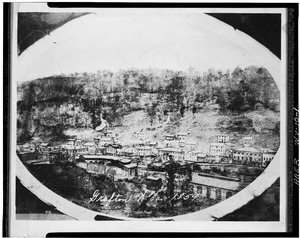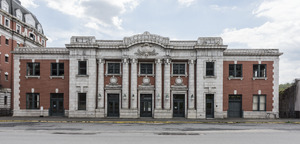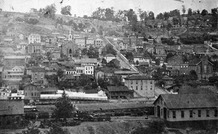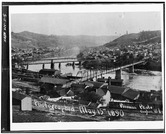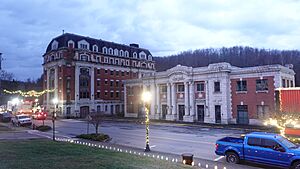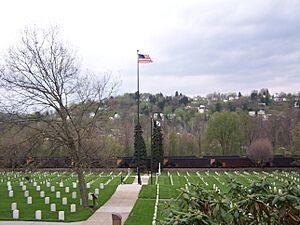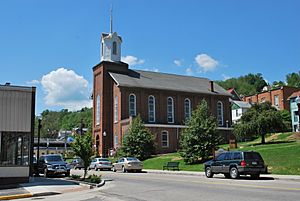Grafton, West Virginia facts for kids
Quick facts for kids
Grafton, West Virginia
|
|||||
|---|---|---|---|---|---|
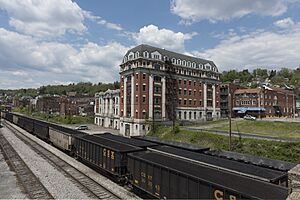
Grafton CSX yard, with the city's downtown in the background
|
|||||
|
|||||
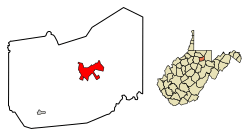
Location of Grafton in Taylor County, West Virginia.
|
|||||
| Country | United States | ||||
| State | West Virginia | ||||
| County | Taylor | ||||
| Area | |||||
| • Total | 3.80 sq mi (9.85 km2) | ||||
| • Land | 3.67 sq mi (9.51 km2) | ||||
| • Water | 0.13 sq mi (0.34 km2) | ||||
| Elevation | 1,024 ft (312 m) | ||||
| Population
(2020)
|
|||||
| • Total | 4,729 | ||||
| • Estimate
(2021)
|
4,651 | ||||
| • Density | 1,356.75/sq mi (523.77/km2) | ||||
| Time zone | UTC-5 (Eastern (EST)) | ||||
| • Summer (DST) | UTC-4 (EDT) | ||||
| ZIP code |
26354
|
||||
| Area code(s) | 304 | ||||
| FIPS code | 54-32716 | ||||
| GNIS feature ID | 1554590 | ||||
Grafton is a city in and the county seat of Taylor County, West Virginia, United States. It is located along the Tygart Valley River. In 2020, its population was 4,729 people.
Grafton started as an important meeting point for the Baltimore and Ohio Railroad. This railroad network was very important for the coal industry in the area.
Grafton is home to both of West Virginia's national cemeteries. It was also where the West Virginia Equal Suffrage Association formed in 1895. This group worked for women's right to vote. Mother's Day was founded in Grafton on May 10, 1908. The city is home to the International Mother's Day Shrine. Grafton was also one of the first cities in the United States to celebrate Memorial Day.
Contents
History of Grafton
How Grafton Got Its Name
The name "Grafton" was first "Grafton Junction." People disagree about where the name came from. It might have been named after John Grafton, a civil engineer for the Baltimore and Ohio Railroad. Or, railroad workers might have called it "Graftin'" because many different train lines met there. It was like they were "grafting" together.
First Settlers in Grafton
Grafton grew from early white settlements where Three Fork Creek meets the Tygart Valley River. This area is part of the Monongahela River's headwaters. In 1776, the Virginia's remote District of West Augusta was split into three counties. One of these, Monongalia County, included what is now Taylor County and Grafton.
James Current (around 1730–1822) and his family were among the first settlers. He was a Scots-Irish immigrant who fought in the Revolutionary War. He moved to Monongalia County by 1782. Family stories say Current traded a "gray horse" for 1,300 acres of land where Grafton is today. James and his wife Margaret are buried in Bluemont Cemetery. This cemetery is part of his original property. Current's grave is the only one in Grafton known to belong to a veteran of the American Revolutionary War.
Roads and Railroads in Grafton
John Wolverton Blue (1803–1889) was in charge of building Virginia's Northwestern Turnpike. This road went from Aurora to the Tygart Valley. In 1833, he visited the future site of Grafton and stayed with the Currents. A local historian said that Blue heard Mrs. Current crying. She was sad about losing her home and garden because of the new road. Blue felt bad and offered them $300 for 900 acres and their home. They quickly accepted.
This area became known as Blueville. It is now a part of Grafton. This area, along with "Valley Bridge" (now Fetterman), started to grow after the Turnpike was finished in 1834. Blue also oversaw the building of a covered bridge over the Tygart River.
In 1847, the Virginia General Assembly allowed the Baltimore and Ohio Railroad Company to extend its line to the Ohio River. The city of Grafton exists because of Thomas Haymond (1794–1869). He was a lawyer and U.S. Congressman. He made sure the railroad line would pass through or near the mouth of Three Fork Creek in Taylor County. This meant the railroad had to go through Grafton.
The B&O railroad workers finished the line on January 11, 1852. The first train arrived two days later. This was the first railroad to cross the Appalachian Mountains. In 1853, only eight families lived in Grafton. But within a year, "Grafton Junction" became a busy railroad town. More homes and stores appeared. As the railroad grew, the new town was planned out. Grafton was officially chartered on March 15, 1856. By this time, 606 people lived there.
Grafton During the Civil War
Grafton was a very important target during the American Civil War (1861-1865). This was because the B&O and Northwestern Virginia Railroads were key for moving soldiers and supplies. Both sides wanted to control it. Most Grafton residents, who were immigrants working for the railroad, supported the Union.
On May 22, 1861, a fight happened in Fetterman, which is now part of Grafton. This fight led to the death of Thornsbury Bailey Brown. He was the first soldier killed in the Civil War.
Union forces soon took control of Grafton. However, Confederate soldiers often raided the area. They tried to damage the railroad operations. In April 1863, the Jones-Imboden Raid aimed to destroy the railroad facilities in Grafton. Raiders did destroy a large bridge in Fairmont, but Grafton's rail yards were protected and not attacked.
Grafton's Growth After the War
After the Civil War, Grafton continued to grow. It became a major shopping and industrial center for North Central West Virginia. President U.S. Grant visited Grafton on September 23, 1872, during his re-election campaign.
In 1878, Grafton became the county seat. This meant it was the main town for Taylor County. A huge flood in 1888 changed the town a lot. It destroyed the old covered bridge at Fetterman. Most of Grafton today was built between 1890 and 1930. John T. McGraw, a rich businessman, helped build many of Grafton's buildings. He also built the streetcar system that was used for many years.
Grafton in the 20th Century
Tygart Dam was built about 2 miles south of Grafton between 1934 and 1938. This was part of a government program called the Works Progress Administration. President Franklin D. Roosevelt visited the city in 1936. He talked about projects like the dam. Upstream from the dam, Tygart Lake State Park was created. This park helps protect the recreation areas around the man-made lake. The Tygart Valley River flows through Grafton.
Grafton continued to do well in the early 1900s. This was because the railroad was so important to the area and the country. But in the 1950s, two big factories closed. The Carr China Plant and the Hazel Atlas Glass Plant both shut down. Hundreds of people lost their jobs.
In 1958, the women of Grafton organized a parade on Main Street. They wanted to attract new jobs for the community. This parade got national attention. Grafton was chosen as the site for a new plastic baby toys factory. Because of the residents' hard work, Grafton received an All-America City Award in 1962. It was the smallest city that year to get the award.
Even though the railroad helped Grafton grow, it also stopped it from expanding. In the 1920s, experts said that the hills, low wind, and many trains caused bad air quality. The smoke from the railroad made it hard for the city to grow. Later, changes in the railroad industry led to more job losses. People moved away to find work.
In the early 1980s, the railroad moved hundreds of jobs to Jacksonville, Florida. This was part of the Chessie System becoming CSX. Grafton suffered a big economic loss from these changes.
The 1985 Election day floods were very bad in Grafton. The Tygart Valley River reached record high levels. At one new station, Three Forks Creek near Grafton, the water flow was very high. It was estimated to be a "100-year flood."
Historic Places in Grafton
The Grafton Downtown Commercial Historic District was added to the National Register of Historic Places in 1984. The Grafton National Cemetery was added in 1982.
Geography of Grafton
Grafton is located at 39°20′30″N 80°1′11″W / 39.34167°N 80.01972°W. It is along the Tygart Valley River. Tygart Lake State Park is a major tourist attraction nearby.
The United States Census Bureau says the city has a total area of 3.80 square miles (9.85 km2). Of this, 3.67 square miles (9.51 km2) is land and 0.13 square miles (0.34 km2) is water.
Population of Grafton
| Historical population | |||
|---|---|---|---|
| Census | Pop. | %± | |
| 1860 | 891 | — | |
| 1870 | 1,987 | 123.0% | |
| 1880 | 3,030 | 52.5% | |
| 1890 | 3,159 | 4.3% | |
| 1900 | 5,650 | 78.9% | |
| 1910 | 7,563 | 33.9% | |
| 1920 | 8,517 | 12.6% | |
| 1930 | 7,737 | −9.2% | |
| 1940 | 7,431 | −4.0% | |
| 1950 | 7,365 | −0.9% | |
| 1960 | 5,791 | −21.4% | |
| 1970 | 6,433 | 11.1% | |
| 1980 | 6,845 | 6.4% | |
| 1990 | 5,524 | −19.3% | |
| 2000 | 5,489 | −0.6% | |
| 2010 | 5,164 | −5.9% | |
| 2020 | 4,729 | −8.4% | |
| 2021 (est.) | 4,651 | −9.9% | |
| U.S. Decennial Census | |||
Grafton's Population in 2010
In 2010, there were 5,164 people living in Grafton. There were 2,192 households and 1,357 families. The population density was about 1,407 people per square mile.
Most of the people (97.1%) were White. About 0.7% were African American, and 0.3% were Native American. About 0.9% of the population was Hispanic or Latino.
The average age in the city was 41.7 years. About 21.9% of residents were under 18 years old. About 19% were 65 years or older. The city had slightly more females (52.4%) than males (47.6%).
National Cemeteries in Grafton
Thornsbury Bailey Brown was the first soldier killed in the Civil War. He is buried at the Grafton National Cemetery. This cemetery opened in 1868. It was a burial place for Union soldiers who died in West Virginia's military hospitals and battlefields. Grafton was chosen because it was close to Maple Avenue Cemetery. That cemetery already had many US Civil War veterans buried there.
On June 14, the first governor of West Virginia, Arthur Boreman, officially opened the cemetery. The cemetery has more than 2,100 burials. This includes 1,252 Union soldiers. There are 613 Civil War soldiers buried whose names are unknown. Their graves are marked with small marble markers. In 1875, a law was passed to make sure the cemetery would be cared for. Two plaques at the cemetery have lines from Theodore O'Hara's poem "Bivouac of the Dead."
On Memorial Day, Grafton National Cemetery has a special tradition called "Flower Strewing Day." Each year, a parade starts in downtown Grafton and goes to the cemetery. There, children from the town place flowers at each grave marker. The day ends with a memorial service. A famous person from West Virginia usually leads this service. Almost every governor of West Virginia has spoken at the Grafton National Cemetery at least once.
Famous People from Grafton
- Clair Bee: An author and basketball coach. He was born in Grafton.
- Martin McNulty Crane: A Texas politician and lawyer. He was born in Grafton.
- Marmaduke H. Dent: A justice of the West Virginia Supreme Court of Appeals. He lived in Grafton for most of his life.
- Frank Gatski: Also known as "Gunner Gatski." He was a Pro Football Hall of Fame center for the Cleveland Browns.
- Robert Halbritter: A politician and judge. He was born in Grafton.
- Anna Jarvis: The person who founded Mother's Day.
- William Jaco: A mathematician at Oklahoma State University. He was born in Grafton.
- Frances Benjamin Johnston: An early photographer and photojournalist. She was born in Grafton.
- George Preston Marshall: The longtime owner and president of the NFL's Washington Redskins. He was born in Grafton.
- Eldora Marie Bolyard Nuzum: The first female editor of a daily newspaper in West Virginia. She interviewed U.S. presidents. She was born in Grafton.
- Ira E. Robinson: A politician and lawyer.
See also
 In Spanish: Grafton (Virginia Occidental) para niños
In Spanish: Grafton (Virginia Occidental) para niños




